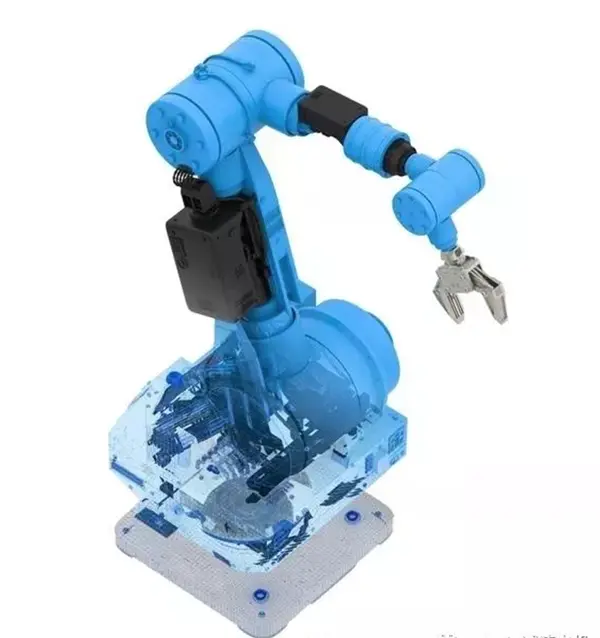Why Applying Retarder instead of Motor Speed to Control Robot Arms?
In this system, we use retarder to control robot arms rather than resorting to motor speed to operate manipulators. But why do we choose retarder instead of motor speed? Why cannot we control robot arms directly by virtue of servomotor rotor without retarder? In order to answer those questions, we need to be clear about the engineering condition of industrial robot joints:
1. Industrial robot joints need to undertake the torque produced by gravity of rear structure.
2. Industrial robot joints have low revolving speed.
The rotational speed of robot joints is rarely low. As the motor rotates unsteadily under low speed, it is necessary to eqiup a machinery to balance the motor's rotating speed at a resonable rate, to ensures a fluent movement. There are two reasons of using retarder. One is to improve the torque. The other is to increase the controlling resolution ratio and the closed-loop precision. For example, a 50:1 harmonic retarder can improve the rated torque of a 100mNm motor to a 5Nm one at the cost of:
1. The rotating speed of rotor is 49 times higher than direct drive.
Essentially, the rotation speed of industrial robot joints is not high as to one or two rotation per second. 100mNm motor can rotate 6k/min. If you want a faster rotating speed, the solution is to elevate the vaoltage, which needs to take the bearing and rotor into consideration.
2. Increase the weight to be 3 times than before.
For instance, the biggest motor rated torque of maxon EC45 is 83mNm, weighting 110g; while the rated torque of maxon EC90 is 560mNm, weighting 600g. Based on those data above, the weight of 5Nm motor can be estimated.
3. When maintaining same torque, the heating power is 1/2500 of that equiped with retarder.
In fact, it doesn't mean that 100mNm rated motor cannot reach 5Nm rate. It can be achieved if you increase the current as much as possible. However, it can cause rapid burnng of motor, which won't last for seconds to end as smoking, leading to a higher energy charge regardless of hydrocooling. If you want to reach a same torque without too much heat, you should change the motor to one with higher torque and heating efficiency, low thermal resistance and larger thermal capacity, which turn to the question we have mentioned in the second point of robot engineering condition.
Moreover, the advantages of using retarder are as following:
1. Having higher resolution ratio at lower price
Motors with higher resolution ratio can control rotating speed more precisely and fluently, for lower high-frequency component.
2. Increasing closed loop precision, better control loop
Rotational inertia of rotors increases 2500 times, leading the lag phase of the control loop. While the torque doesn't lag behind caused by stiffness as the rotor is directly diven by electromagnetic force, which is easier to control compared with that of direct drive.
Other than solutions of a technical nature, here is another case which can answer those questions from an indirect perspective. Except for obtaining low-speed and large-torque property, using retarder can also bring larger drive ratio (level 2 or higher) compared with that of DC motor applied in robots.

Certainly, retarder is not perfect without any defects. However, with the comparison of those two cases, it is more suitable to choose retarder for use.
Shortages of using retarder:
1. If the retarder is equiped while the encoder is at the motor end, the manufacturing presicion will go against the actual accuracy.
2. Minor errors caused by the variation in thickness of oil film between tooth space in multi-level retarder will be amplified to decrease the repeated accuracy.
3. Gear engagement and flexspline deformation of retarder limit its service life.
4. The nonlinear coupling of multi-link mechanism tooth space worsen the robot's absolute accuracy, so that we take over from it with repeated accuracy. It also make pure offline programming of robots difficult, increasing the difficulty and cost of deployment.
The above is to answer why we cannot operate robot joints by controlling rotating speed of servomotor rotors but by using retarder. Although there are robots equiped with direct drive motor, because of those problems we have mentioned, those robots lack a bit of maturity. In a word, using retarder in industrial robots helps their motors gain high torque instead of applying high rotation speed that motors are easy to reach.
Runma Intelligent uses retarder from Japan Xinbao. Why choosing the brand Xinbao?
Characteristics of Xinbao retarder:
1. High precision
The gear back clearance is 0.05°, belonging to high precision series, which gives full play to precise location, making best use of the characteristics of high precision servo motor.
2. High rigidity
Adopt structural steel to process the machine body.
3. Conical roller bearing
Using integrated roller bearing to improve rigidity and torque.
4. High-load capacity
The main bearing adopts conical roller bearng, realizing high-load capacity.
5. Flange and shaft sleeve solution
They can be installed in any servo motors in the world.
6. No lubricating grease leakage
Using high viscosity lubricating grease that is not easy to separate can effectly avoid leaking of lubricating grease.
7. Long service life
Using durable, low-abrasion and high-class lubricating grease can dispense with long-time maintenance (20000 hours).